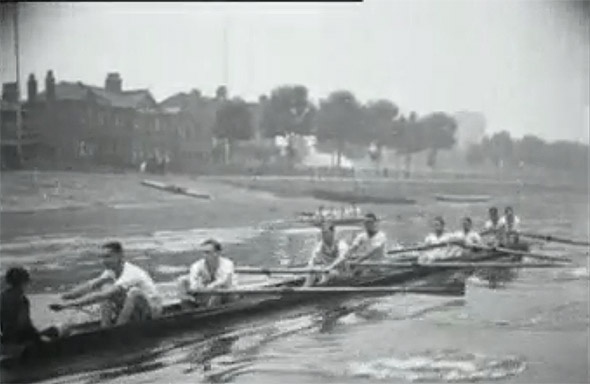 |
Birds flying in formation gain
efficiency by taking advantage of the vortex turbulence set up
by the forward bird.
The red dot represents the turbulence, which remains relatively
stationary.
Similarly, would the oar stroke be more efficient if it were
stroking in the same location as the previous oar?
Any advantage it is dependent on the
speed of travel.
|
History
The Centipede concept is not new. The notion of using alternative
rowing strokes has been tried in the past, with mixed success.
As an example of this, you can see a 1929 silent Pathe Movie clip, demonstrating that sequential rowing is
possible.

Here is "The London Rowing Club trying out Major Hellyer's revolutionary "Syncopated Rowing" experiment, designed to do away with checking "the run of the boat" in the orthodox style."
What makes the Centipede an attractive alternative today
is the advance of technology as mentioned below.
Learning to row the Centipede
Practice is best performed on dry land.
Initially, it is easier to learn Centipede rowing by being blindfolded,
or using opaque glasses. The simplest technique is to have the stroke
announced, "1-2-3-4-5-6-7-8" repeatedly. If you are oar number three,
you would stroke the water at "3" if you are oar number seven, you would
stroke the water at "7".
A more sophisticated way of regulating the stroke is
to have an eight channel recording, allowing each rower to hear their
specific strokes in a headphone.
The recording rate can be increased or decreased, enabling variable
speed.
If each stroke takes two seconds, there is a 0.25
sec. delay between each rower in line. As this method of rowing has not
yet been tested yet, I have as yet no way of knowing if 0.25 sec. is
enough time to lift the oar above the knees before the next rower
catches up.
Summary
The Centipede - sequential rowing - remains a
tantalizing curiosity; it has not to date been tried.
Does the consistent torque significantly increase rowing efficiency?
Do the placing of oars on the same location in the water effect the oar
pull?
One thing is for sure; someone sometime is going to try it, and if
proves to be an efficient technique, rowing history will be changed.
Stephen
Goodfellow, February 14th, 1997
Return
|

